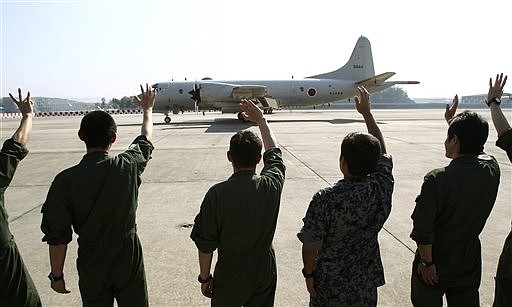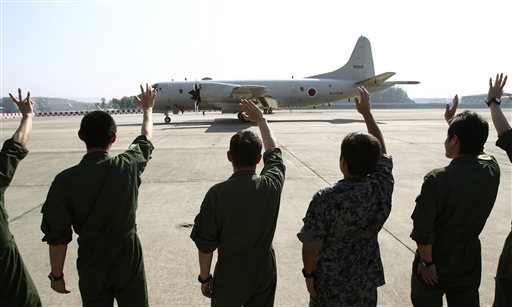KUALA LUMPUR, Malaysia - More planes joined the search Sunday of a remote patch of the southern Indian Ocean in hopes of finding answers to the fate of the missing Malaysia Airlines jet, after China released a satellite image showing a large object floating in the search zone.
The desolate area in the Indian Ocean is about 2,500 kilometers (1,550 miles) southwest of Perth, Australia, where three days of searching for similar images from another satellite that emerged earlier in the week have produced no results.
The Australian Maritime Safety Authority, which is coordinating the operation from the country's western coast, said it refined the search based on the latest clue from the Chinese satellite showing an object that appeared to be 22 meters (72 feet) by 13 meters (43 feet). It said the object's position also fell within Saturday's search area but it had not been sighted.
Sunday's search involving eight aircraft has been split into two areas within the same proximity covering 59,000 square kilometers (22,800 square miles). These areas have been determined by drift modelling, the AMSA said.
Despite the frustrating lack of answers, Australian Prime Minister Tony Abbott was upbeat.
"Obviously we have now had a number of very credible leads and there is increasing hope - no more than hope, no more than hope - that we might be on the road to discovering what did happen to this ill-fated aircraft," Abbott told reporters in Papua New Guinea.
Malaysian Defense Minister Hishammuddin Hussein put a message on his Twitter account Sunday asking those in churches around the country to offer a "prayer please" for the passengers and crew on Fight 370.
More than 300 Malaysian cycling enthusiasts rode their bikes to the Kuala Lumpur airport to remember the people onboard the jet. The cyclists decorated the bikes with small Malaysian flags and stickers that read "Pray for MH370."
Seven planes left a base near Perth, where an intense wind was blowing, for a four-hour journey to the search region, the safety authority said. One more will fly out later. The HMAS Success, an Australian navy supply ship, is also taking part.
A cold front was forecast to move through the region later Sunday, which could bring clouds and wind, further hampering efforts to locate any debris thought to be from the plane.
The latest satellite image is another clue in the baffling search for Flight 370, which dropped off air traffic control screens March 8 over the Gulf of Thailand with 239 people on board.
"China hopes that these data will be helpful for searching and rescuing efforts," Chinese Foreign Ministry spokesman Hong Lei said in a statement.
The missing plane, which had been bound for Beijing, carried 153 Chinese passengers.
After about a week of confusion, Malaysian authorities said pings sent by the Boeing 777-200 for several hours after it disappeared indicated that the plane ended up in one of two huge arcs: a northern corridor stretching from Malaysia to Central Asia, or a southern corridor that stretches toward Antarctica.
The discovery of the initial two objects by a satellite led several countries to send planes and ships to a stretch of the ocean southwest of Australia. But three days of searching have produced no confirmed signs of the plane.
One of the objects spotted in the earlier satellite imagery was described as 24 meters (almost 80 feet) in length and the other was 5 meters (15 feet).
In a statement on its website announcing China's find, the State Administration of Science, Technology and Industry for National Defense did not explain why it took four days to release the information. But there was a similar delay in the release of the initial satellite images because experts needed time to examine them.
Two military planes from China have arrived in Perth, and the AMSA said they would join the search on Monday. They join Australian, New Zealand and U.S. aircraft. Japanese planes are also expected soon.
Even if both satellites detected the same object, it may be unrelated to the plane. One possibility is that it could have fallen off a cargo vessel.
Because the search area is a four-hour flight from land, some of the planes can search for about only two hours before they must fly back. Others may be able to stay for up to five hours before heading back to the base.
The area where the objects were first identified by the Australian authorities is marked by strong currents and rough seas, and the ocean depth varies between 1,150 meters (3,770 feet) and 7,000 meters (23,000 feet).
Malaysian authorities have not ruled out any possible explanation for what happened to the jet, but have said the evidence so far suggests it was deliberately turned back across Malaysia to the Strait of Malacca, with its communications systems disabled. They are unsure what happened next.
Police are considering the possibilities of hijacking, sabotage, terrorism or issues related to the mental health of the pilots or anyone else on board.
Malaysia has also asked the U.S. for undersea surveillance equipment to help in the search.

